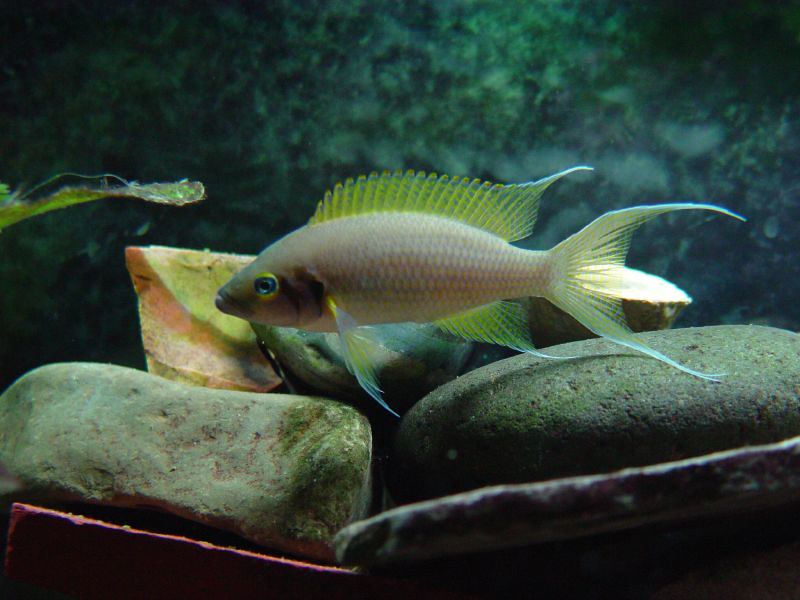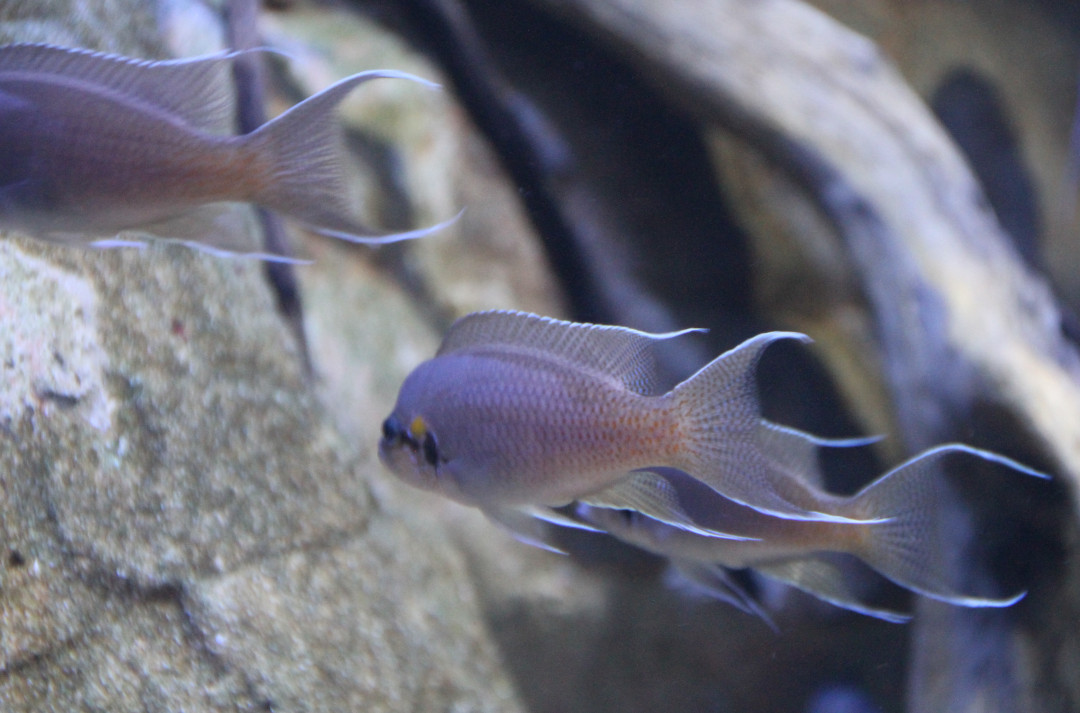Fairy Cichlid
The Fairy Cichlid, Neolamprologus brichardi, is an ethereal, easy-to-breed fish species known for its lyre-shaped fins and tail dotted with white spots. Its charming spawning behavior and distinctive appearance have made the Tanganyika Fairy cichlid a preferred choice among beginner and experienced aquarium enthusiasts.
- Experience Level: Intermediate
- Hardiness: Moderately Hardy
- Minimum Tank Size: 75 gal (285 L)
- Maximum Size: 6 inches (15 cm)
- Temperament: Peaceful / Although can be territorial and aggressive
- Temperature: 72 – 79° F (22 – 26° C)
- pH Range: 8.0 – 8.5
- Water Hardness: 15 – 25 dGH
- Diet: Omnivore
Table of Contents
Introduction
Size and Appearance
Care Guide
Tank Mates
Diet and Feeding
Breeding
As a petite member of the cichlid family, the Neolamprologus brichardi inhabits rocky zones along the coastline of Lake Tanganyika, thriving in both shallow and deep waters from 10 to around 98 feet. These elegant fish dwell in large shoals, counting up to hundreds at times.
Significantly, while Princess cichlids usually swim in massive shoals, they form committed pairs when breeding. Their natural diet includes biofilm from the rocky substrate, tiny crustaceans, and invertebrates. They also feed on floating swarms of plankton.
Size and Appearance
This attractive fish species, known as Fairy Cichlid, exhibits a slender, elongated body with a continuous dorsal fin and lyre-shaped caudal fin. The unpaired fins are adorned with long, flowing filaments, adding to the breed’s elegance.
Wild specimens grow up to 4 to 5 inches, but in home aquariums, this size can increase to around 6 inches. With dedicated care and balanced nutrition, these fish can live for eight to ten years.
The coloration of Neolamprologus brichardi is visually striking. They flaunt a pale brown body tinged with yellow near the tail, while their eyes pop with a vibrant blue hue. A pattern of blue lines starting below their eyes and extending from the lip to the gill covering creates a visually striking display. A thick black stripe runs horizontally from the eye to the gill cover, which has a bright yellow or gold patch above it.
Care Guide
- Minimum Tank Size: 75 gal (285 L)
- pH Range: 8.0 – 8.5
- Water Hardness: 15 – 25 dGH
- Temperature: 72 – 79° F (22 – 26° C)
- Lighting: Moderate, diffused lighting
- Substrate: Fine sand/gravel
- Brackish: No
- Water Flow: Moderate to Strong
- Tank Region: All areas
Suitable for both newcomers and experienced hobbyists to aquarium keeping, the Princess Cichlid is fairly simple to manage. This wide-ranging breed readily accepts various types of commercially available aquatic feeds and breeds easily in aquarium environments.
If you’re planning a one-species tank, a minimum size of 75 gallons is recommended, although a 125 gallon tank is more suitable. A community aquarium would necessitate a 125 gallon tank or larger. With an affinity for strenuous currents, these fish prefer a highly effective filtration system resembling their native Lake Tanganyika, rich in oxygen and fresh water.
Implementing a regular testing schedule for pH and nitrate levels is crucial. The nitrate amount should be kept below 15 ppm, and the pH level should not drop below 7.5. Measuring the total hardness and carbonate hardness of the aquarium water is also necessary.
Due to their sensitivity to drastic water changes, the Fairy Cichlid thrives in consistent water conditions, similar to their native Lake Tanganyika, which is the world’s second-largest and deepest lake. Striving to maintain water conditions within their ideal range, between 72 F and 79 F helps in their adaptation to the aquarium environment. Extreme temperature shifts, below 68 F or above 86 F, for prolonged periods can be detrimental to the breed.
To replicate their natural alkaline water habitat, your tank’s pH level must be maintained at 9 with a dGH between 15-25. Since the lake water is quite hard, it’s important to ensure efficient filtration and aeration, as in Lake Tanganyika. Employing regular maintenance routines and using aquarium salt or crushed coral for buffering water hardness might be beneficial.
One key factor to remember while setting up your tank would be to emulate the natural living environment of the Neolamprologus brichardi. A 75 gallon tank or larger would be ideal to accommodate the Fairy Cichlid. The substrate can be sand, crushed coral, or fine gravel, and a plethora of rocks can be used to create caves and crevices. When installing rock formations, ensure safety measures are observed to prevent any mishaps. Furthermore, sufficient open space should be left for the fish to swim freely.
Tank Mates
Known to be slightly aggressive, the Neolamprologus brichardi is extremely territorial, particularly during breeding periods. These fish can become hostile during breeding, which is why caution should be exercised when housing them with Tanganyikan shell dwellers, Cyprichromis, or Synodontis catfish in a sizable tank. As a rule, delicate invertebrates and Dwarf shrimp should not share a tank with the Princess cichlids.
Feeding Guide
- Diet: Omnivore
- Frequency: Several small feedings per day
- Pellet Foods: Yes
- Flake Foods: Yes
- Live Foods: Yes
- Meat Foods: Yes
- Vegetable Foods: Yes
Being omnivores, Fairy Cichlids thrive on a diet that includes fresh, live, and flake foods. For promoting overall health, daily serving of quality flake food or pellets is recommended. A proper diet includes high-quality live meaty foods supplemented with frozen and dry foods.
Even though the Fairy cichlid is carnivorous, the inclusion of vegetable matter like blanched spinach or spirulina is beneficial. Regular smaller feedings are favored over a single, larger feeding to control waste production and maintain water quality. It is not uncommon to find Neolamprologus brichardi benefiting from occasional fasting.
Breeding
Breeding cichlids in an aquarium can be a simple process, with the Neolamprologus brichardi being no exception. These fish prefer caves as spawning sites, accessible within the aquarium in the form of strategically placed flowerpots or rock formations.
Neolamprologus brichardi mate in pairs for life, often forming strong bonds. The fry are large enough to feast on brine shrimp nauplii immediately after being born. As the fry swims freely, introduce them to a diet of freshly-hatched brine shrimp, crushed flakes, and finely powdered nutrient-rich foods.
Be wary of overpopulation in your tank as it may lead to reduced breeding and possibly cannibalism among these fish. To avoid such adverse conditions, it might be advisable to transfer the fry to a separate rearing tank. This also prevents potential deformities that can occur due to inbreeding among the fish.



